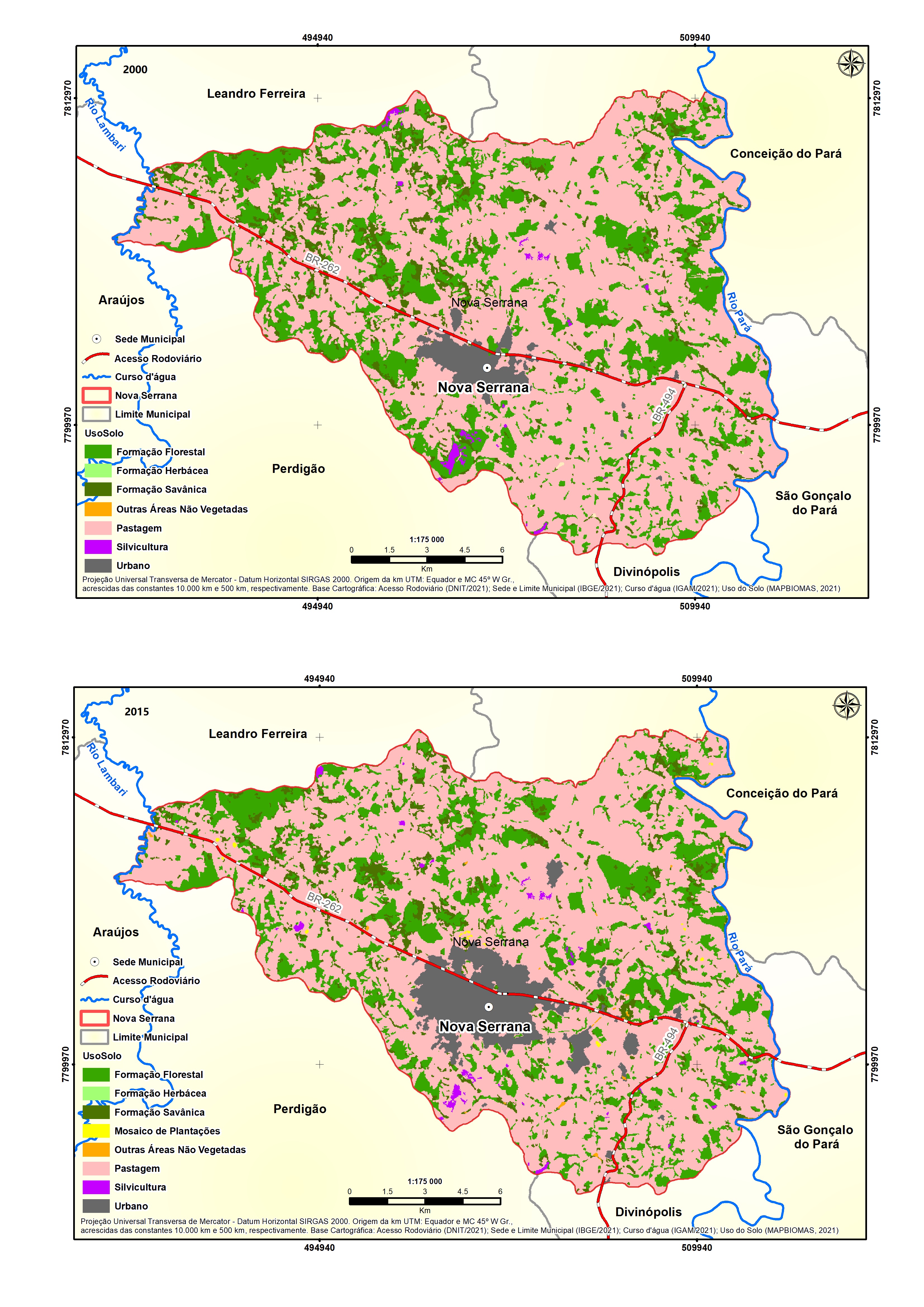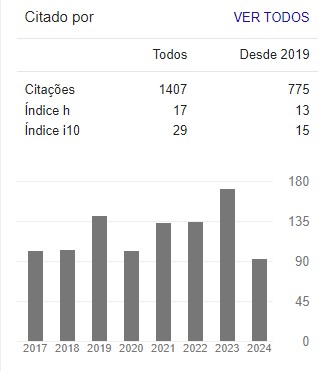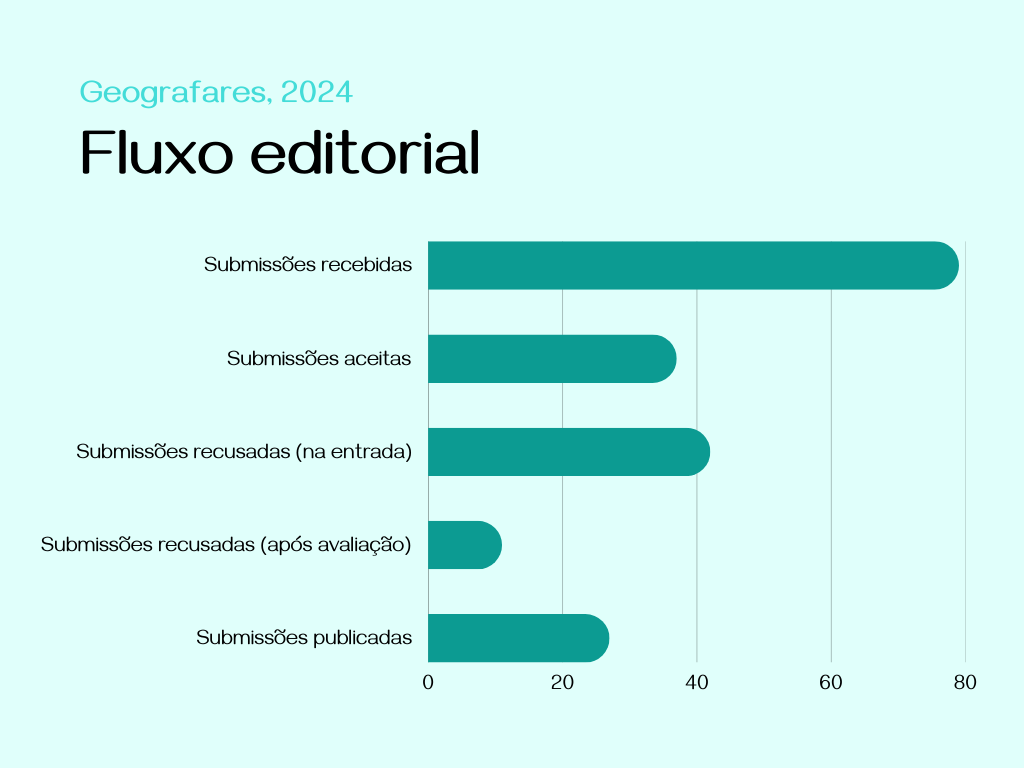Urban Expansion and the Provisioning of Ecosystem Services in Nova Serrana, Minas Gerais, Brazil
DOI:
https://doi.org/10.47456/geo.v4i38.40701Keywords:
environmental losses, landscape metrics, urbanizationAbstract
Fragments of native vegetation within the landscape play a crucial role in providing ecosystem services (ES). Ecosystem services have become increasingly important in recent years, particularly in response to recurrent land use changes. This article aims to identify and analyze the impacts of urban expansion in Nova Serrana, MG, Brazil, on the provision of local ecosystem services. Landscape metrics were used to quantify changes in spatial composition and to comprehend the outcomes of processes that occurred over 15 years. Our results indicate a loss of 781 hectares of natural vegetation patches (including forests and savannah), mainly attributed to the expansion of urban areas. Furthermore, field campaigns revealed additional environmental issues not apparent in satellite images, such as local flooding, loss of springs, and air pollution from shoe factories. These issues are all consequences of the degradation of ecosystem services.
Downloads
References
ANDRADE, D. C.; ROMEIRO, A. R. Capital natural, serviços ecossistêmicos e sistema econômico: rumo a uma Economia dos Ecossistemas. Texto para Discussão. IE/UNICAMP, n. 159, 2009.
CARLOS, A. F. A. A reprodução do espaço urbano como momento da acumulação capitalista. In: CARLOS, A. F. A. (org.). Crise urbana. São Paulo: Contexto, 2015. p. 25-35.
CASTELLS, M. A questão urbana. Rio de Janeiro: Paz e Terra. 2000.
CORRÊA, R. L. O espaço urbano: notas teórico-metodológicas. Geosul, Florianópolis, v. 8, n. 15, p. 13-18, jan. 1993.
BACHI, L.; CORRÊA, D.; FONSECA, C.; CARVALHO-RIBEIRO, S. Are there bright spots in an agriculture frontier? Characterizing seeds of good Anthropocene in Matopiba, Brazil. Environmental Development, [S.L.], v. 46, p. 100856, jun. 2023. Elsevier BV. http://dx.doi.org/10.1016/j.envdev.2023.100856.
BOTEQUILHA-LEITÃO, A.; AHERN, J. Applying landscape ecological concepts and metrics in sustainable landscape planning. Landscape and Urban Planning, v. 59, 2002.
BURKHARD, B.; KROLL, F.; MÜLLER, F. & WINDHORST, W. Landscapes’ capacities to provide ecosystem services – a concept for land-cover based assessments. Landscape Online, v. 15, 2009. Disponível em: https://doi.org/10.3097/LO.200915.
CÂMARA, G.; MONTEITO, A. M. DRUCK, S.; CARVALHO, M. S. Análise espacial e geoprocessamento. In: DRUCK, s.; CARVALHO, M. S; CÂMARA, G.; MONTEIRO, A. M. Análise espacial de dados geográficos. Brasília/DF: EMBRAPA, 2004.
CARVALHO-RIBEIRO, S.; LOVETT, A. Associations between forest characteristics and socio-economic development: A case study from Portugal. Journal of Environmental Management, v. 90, n. 9, p. 2873–2881, 2009.
RIBEIRO, S. M. C. et al. Can multifunctional livelihoods including recreational ecosystem services (RES) and non timber forest products (NTFP) maintain biodiverse forests in the Brazilian Amazon? Ecosystem Services, [S.L.], v. 31, p. 517-526, jun. 2018. Elsevier BV. http://dx.doi.org/10.1016/j.ecoser.2018.03.016.
CNM (Confederação Nacional de Municípios). Guia para Localização dos Objetivos de Desenvolvimento Sustentável nos Municípios Brasileiros. O que os gestores municipais precisam saber. Brasília/DF: CNM, 2016. Disponível em: https://www.cnm.org.br/biblioteca/exibe/2855. Acessado em: 10 de janeiro de 2021.
COSTANZA, R. et al. The value of the world’s ecosystem services and natural. Nature, v. 387, n. May, p. 253–260, 1997.
COSTANZA, Robert. Social Goals and the Valuation of Ecosystem Services. Ecosystems, [S.L.], v. 3, n. 1, p. 4-10, jan. 2000. Springer Science and Business Media LLC. http://dx.doi.org/10.1007/s100210000002.
COSTANZA, R.; DE GROOT, R.; BRAAT, L.; KUBISZEWSKI, I.; FIORAMONTI, L.; SUTTON, P.; FARBER, S.; GRASSO, M. Twenty years of ecosystem services: How far have we come and how far do we still need to go? Ecosystem Services, v. 28, 2017. https://doi.org/10.1016/j.ecoser.2017.09.008.
CROCCO, M.; SANTOS, F.; SIMÕES R.; HORÁCIO, F. Industrialização descentralizada: sistemas industriais locais. O arranjo produtivo calçadista de Nova Serrana (MG). Revista Parcerias Estratégicas, v. 15, n. 17, 2003.
DADASHPOOR, H.; AZIZI, P.; MOGHADASI, M. Land use change, urbanization, and change in landscape pattern in a metropolitan area. Science of the Total Environment, v. 655, 2019. https://doi.org/10.1016/j.scitotenv.2018.11.267.
MONTE-MÓR, R. L. de M. Urbanização extensiva e lógicas de povoamento: um olhar ambiental. In: LIMONAD, E. Etc Espaço, Tempo e Crítica. Rio de Janeiro: Letra Capital, 2019. p. 251-262. Disponível em: https://issuu.com/phil_o_mena/docs/livro_-_etc. Acesso em: 19 jun. 2024.
DE GROOT, R. S. Functions of Nature: Evaluation of Nature in Environmental Planning, Management and Decision Making. Wolters-Noordhoff BV, Groningen, 1992.
DE GROOT, R. S. Function-analysis and valuation as a tool to assess land use conflicts in planning for sustainable, multi-functional landscapes. Landscape and Urban Planning, 2006. Disponível em: https://doi.org/10.1016/j.landurbplan.2005.02.016
DUARTE, G. T.; SANTOS, P. M.; CORNELISSEN, T. G.; RIBEIRO, M. C. et al. The effects of landscape patterns on ecosystem services: meta-analyses of landscape services. Landscape Ecology, n. 8, 2018. Disponível em: https://doi.org/10.1007/s10980-018-0673-5.
FERREIRA, L. H. S.; FARIA, A.V.; LEITE, A. F. B. Migração e mercado de trabalho: uma análise sobre o município de nova serrana-mg e sua indústria calçadista. VII Congreso de la Asociación Latino Americana de Población e XX Encontro Nacional de Estudos Populacionais, Foz do Iguaçu/PR, 2016.
FORMAN, R. T. T., GORDON, M. Landscape Ecology. New York: Jonh Wile & Sons, 1986.
HARVEY, D. The urban process under capitalism. In: DEAR, M.; SCOTT, A. J. (ed.), Urbanization and urban planning in capitalist societies. New York: Methuen and Co., p. 91-122, 1981.
HINATA, S. S.; BASSO, L. A.; SANTOS, J. G. Mapeamento e avaliação dos serviços ecossistêmicos entre 1985 e 2019 na sub-bacia hidrográfica do Arroio Passo Fundo (Guaíba/RS). Sociedade & Natureza, v. 33, 2021. Disponível em: https://doi.org/10.14393/SN-v33-2021-59170
IBGE – INSTITUTO BRASILEIRO DE GEOGRAFIA E ESTATÍSTICA. Limites municipais de 2021. IBGE, 2021. Disponível em: https://www.ibge.gov.br/geociencias/organizacao-do-territorio/malhas-territoriais/15774-malhas.html?=&t=acesso-ao-produto. Acessado em: 05 mar. 2021.
IBGE – INSTITUTO BRASILEIRO DE GEOGRAFIA E ESTATÍSTICA. Cidades e estados. IBGE, 2020 Disponível em: https://www.ibge.gov.br/cidades-e-estados/mg/nova-serrana.html. Acessado em: 22 out. 2020.
JUNIOR, O. F. ARAÚJO, G. M. Fauna e Flora do Triângulo Mineiro e Alto Paranaíba. Uberlândia/MG: CCBE/FUNDEP, 2007.
LANG, S.; BLASCHKE, T. Análise da paisagem com SIG. São Paulo: Oficina de Textos, 2009.
LAUSCH, A. et al. Understanding and quantifying landscape structure – A review on relevant process characteristics, data models and landscape metrics. Ecological Modelling, [S.L.], v. 295, p. 31-41, jan. 2015. Elsevier BV. http://dx.doi.org/10.1016/j.ecolmodel.2014.08.018.
LEFEBVRE, H. A produção do espaço. Tradução Doralice Barros Pereira e Sérgio Martins (do original: La production de l’espace). 4e éd. Paris: Éditions Anthropos, 2000), 2006, 265 p.
LEI COMPLEMENTAR 36/2022. Plano Diretor Participativo Municipal de Nova Serrana. PNS, 2022.
LEI 4.771/1965. Código Florestal. Brasil, 1965.
LEI 12.651/2012. Novo Código Florestal. Brasil, 2012.
LIN, J. et al. What is the influence of landscape metric selection on the calibration of land-use/cover simulation models? Environmental Modelling and Software, v. 129, n. January, p. 104719, 2020. Disponível em: https://doi.org/10.1016/j.envsoft.2020.104719.
LOBO, C. Dispersão espacial da população no Brasil. Mercator, v. 15, p. 19-36, 2016.
MARTENSEN, A. C.; PIMENTEL, R. G.; METZGER, J. P. Relative effects of fragment size and connectivity on bird community in the Atlantic Rain Forest: Implications for conservation. Biological Conservation, v. 141, n. 9, p. 2184–2192, 2008.
MCGARIGAL, K.; CUSHMAN, S.; NEEL, M.; ENE, E. FRAGSTATS: Spatial Pattern Analysis Program for Categorical Maps. Amherst, 2002.
MCGARIGAL, K. Fragstats Help. University of Massachusetts, Amherst, v. 4, n. April, p. 1-182, 2015.
METZGER, J. P. O que é Ecologia de Paisagens? Biota Neotrópica. v.1, n. 1, 2001. Disponível em: https://doi.org/10.1590/S1676-06032001000100006.
MA (Millenium Ecosystem Assesment). Ecosystems and human well-being: a framework for assessment. Washington, DC: Island Press, 2003.
MA (Millenium Ecosystem Assesment). Ecosystems and human wellbeing: synthesis. Washington, DC: Island Press, 2005.
MAPBIOMAS (Projeto Mapbiomas). Coleção 5 da Série Anual de Mapas de Cobertura e Uso de Solo do Brasil. Acessado em: 25 de outubro de 2020. Disponível em: https://mapbiomas.org/mosaicos-landsat?cama_set_language=pt-BR.
MARTINE, G.; MCGRANAHAN, G. A transição urbana brasileira: trajetória, dificuldades e lições aprendidas. In: BAENINGER, R. (org). População e Cidades subsídios para o planejamento e para as políticas sociais. Campinas/SP: Núcleo de Estudos de População-Nepo/Unicamp, 2010.
MOULIN, A. Urbanização brasileira. Um Olhar Sobre o Papel das Cidades Médias na Primeira Década do Século XXI. R. B. Estudos Urbanos e Regionais, v.12, 2010.
NARDUCCI. J.; QUINTAS-SORIANO, G.; CASTRO. A.; SOM-CASTELLANO, R. Implications of urban growth and farmland loss for ecosystem services in the western United States. Land Use Policy, 2019. Disponível em: https://doi.org/10.1016/j.landusepol.2019.04.029.
OLIVEIRA, J. C. et al. Análise da qualidade das águas superficiais da bacia hidrográfica do rio Pará -MG. Florianópolis/SC: ABRH, 2017.
ONU (Organização das Nações Unidas). Relatório Perspectivas de urbanização mundial. Nova Iorque: Departamento de Assuntos Econômicos e Sociais/ Divisão de População, 2024.
OJIMA, R. A urbanização contemporânea e as dimensões humanas das mudanças ambientais globais. In: HORGAN, D. J. (org.). Dinâmica populacional e mudança ambiental: cenários para o desenvolvimento brasileiro. Campinas/SP: Núcleo de Estudos de População-Nepo/Unicamp, 1ª edição, 2007.
O’SULLIVAN, J. N. The social and environmental influences of population growth rate and demographic pressure deserve greater attention in ecological economics. Ecological Economics, 2020. https://doi.org/10.1016/j.ecolecon.2020.106648.
PEREIRA, T. K. MORO, R. S.; NOGUEIRA, M. K. F. S.; DIAS, W. A paisagem da bacia do rio Pitangui sobre a escarpa devoniana, Ponta Grossa, Paraná. Sociedade & Natureza, v. 25, n. 3, 2013. Disponível em: https://doi.org/10.1590/S1982-45132013000300010.
RIITTERS K. Pattern Metrics for a Transdisciplinary Landscape Ecology. Landscape Ecology, v. 34, n. 9, 2019. Disponível em: https://doi.org/10.1007/s10980-018-0755-4.
RIBEIRO, H.; VARGAS, H. C. Urbanização. Globalização e saúde. São Paulo/SP: Revista USP, 2015. Disponível em: https://doi.org/10.11606/issn.2316-9036.v0i107p13-26
SANTOS. H. N.; FILHO, E. R. Processos de produção e trabalho no Arranjo Produtivo Local calçadista de Nova Serrana. GEPROS. Gestão da Produção, Operações e Sistemas, Bauru, Ano 8, nº 2, 2012.
SINDINOVA (Sindicato Intermunicipal de Indústrias de Calçados de Nova Serrana). Disponível em: http://www.sindinova.com.br/novo/nova-serrana/. Acesso em: 14 de outubro de 2020.
SOWIŃSKA-ŚWIERKOSZ, B. N.; SOSZYŃSKI, D. Landscape structure versus the effectiveness of nature conservation: Roztocze region case study (Poland). Ecological Indicators, v. 43, p. 143–153, 2014.
SOUZA, M. L. Quando o trunfo se revela um fardo: reexa-minando os percalços de um campo disciplinar que se preten-deu uma ponte entre o conhecimento da natureza e o da so-ciedade. Geousp – Espaço e Tempo (Online), v. 22, n. 2, p. 274-308, 2018. ISSN 2179-0892.
SUZIGAN, W.; FURTADO, J.; GARCIA, R.; SAMPAIO, S. E. K. A indústria de calçados de Nova Serrana (MG). Nova Economia, Belo Horizonte, v. 15, n. 3, p. 97-116, dez. 2005. FapUNIFESP (SciELO). http://dx.doi.org/10.1590/s0103-63512005000300004.
UUEMAA, E.; MANDER, Ü.; MARJA, R. Trends in the use of landscape spatial metrics as landscape indicators: a review. Ecological Indicators, 2013. Disponível em: https://doi.org/10.1016/j.ecolind.2012.07.018.
WANG, Y. et al. Delimitation of ecological corridors in a highly urbanizing region based on circuit theory and MSPA. Ecological Indicators, v. 142, n. July, p. 109258, 2022. Disponível em: https://doi.org/10.1016/j.ecolind.2022.109258.
WEI, L. et al. Evaluating the impact of urban expansion on the habitat quality and constructing ecological security patterns : A case study of Jiziwan in the Yellow River Basin, China. Ecological Indicators, v. 145, n. April, p. 109544, 2022. Disponível em: https://doi.org/10.1016/j.ecolind.2022.109544.
XIE, W.; HUANG, Q.; HE. C.; ZHAO, X. Projecting the impacts of urban expansion on simultaneous losses of ecosystem services: A case study in Beijing, China. Ecological Indicators, 2017. Disponível em: https://doi.org/10.1016/j.ecolind.2017.08.055.

Published
How to Cite
Issue
Section
License
Copyright (c) 2024 Geografares

This work is licensed under a Creative Commons Attribution 4.0 International License.
Copyrights Declaration
Authors who publish in the journal agree with the following terms:
- Authors will keep their copyrights and grant the journal the right to their first publishing, simultaneously licenced under Creative Commons Attribution License which allows sharing their work with authorship recognition and initial release through this journal.
- Authors may sign additional contracts separately diffusing a non-exclusively version of the paper published in this journal (i.g. publishing in institutional repository or as a book chapter), once citing the authorship and initial release through this journal.
- Authors are encouraged to publicize and diffuse their paper online, for example onto institutional repositories or on their personal websites.


























